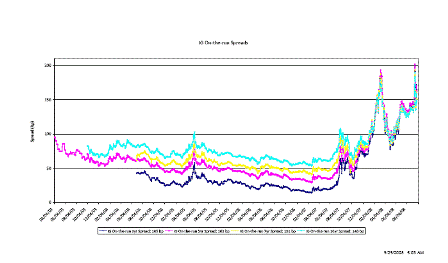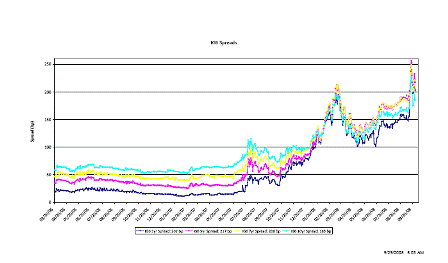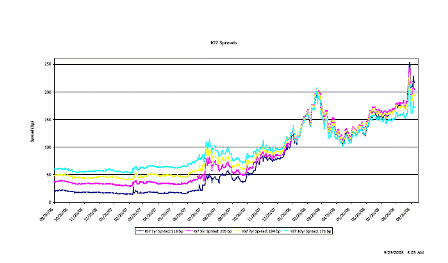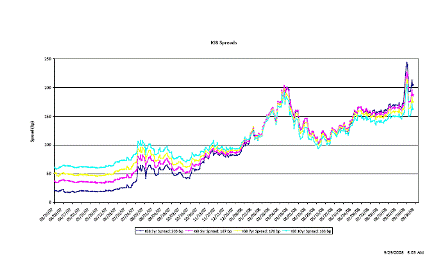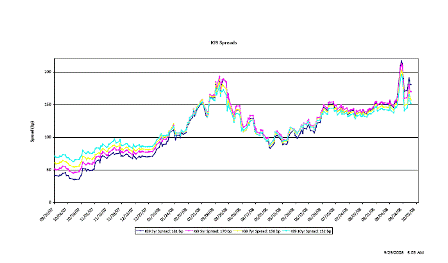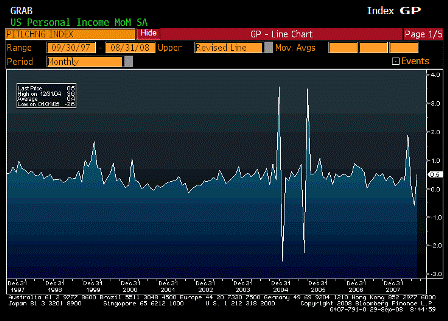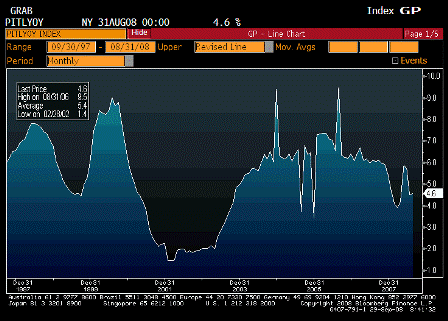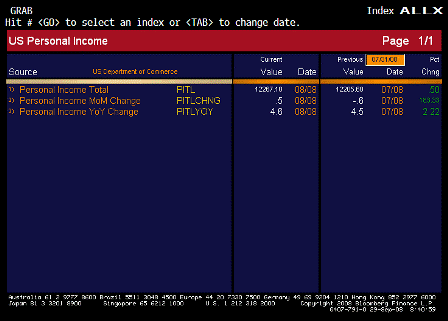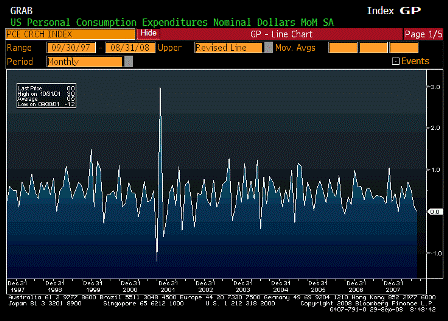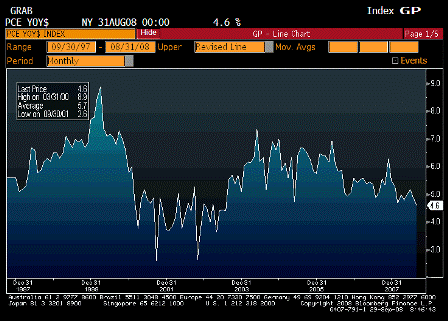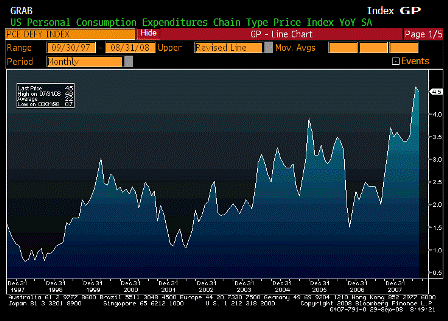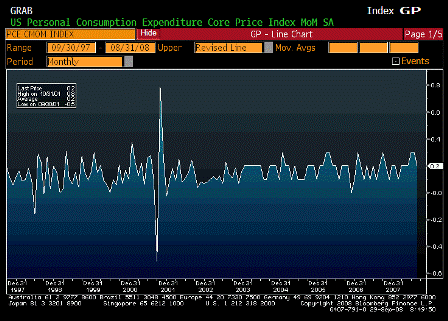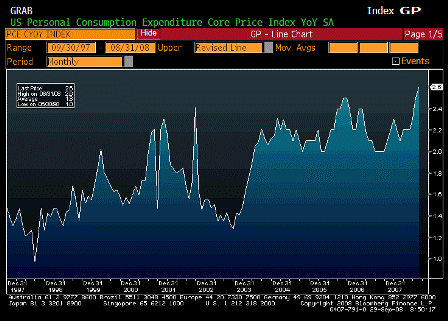[Skip to the end]
The combination of removing the FDIC cap and extending FDIC insurance to include Fed deposits at member banks will normalize bank liquidity instantly, and at no ‘cost’ to government, by removing these ‘self-imposed constraints’ on bank liquidity that serve no function beyond contributing to the current liquidity crisis.
Supporting demand is a separate matter. Supporting lending will help, but there is no substitute for supporting incomes.
The TARP will not normalize bank liquidity or add to demand. It’s just an asset exchange. Not a bad thing, but nothing that dramatically changes anything.
And, unfortunately, and not to further complicate matters regarding the financial crisis, anything that does succeed in restoring growth will increase gasoline consumption and support prices at new highs in short order.
The over riding theme for Congress is the notion of ‘public purpose’.
New comments highlighted in yellow:
-
Money fund issue:
Remove the $100,000 cap on insured bank deposits. This adds no risk to government. And it will eliminate the need for money funds which the cap created in the first place.
Reasons for the cap: small banks will lose money to large banks.
When combined with 5., below, the Fed lending unsecured and in any size to any solvent member bank this objection vanishes:
-
Banks:
Lower the discount rate to the fed funds target rate and eliminate the need for collateral. This is how it should have been anyway. This goes hand in hand with eliminating the cap on FDIC insured deposits. The easiest way to facilitate this may be to extend FDIC insurance to Fed deposits at member banks. Then the Fed won’t need to demand collateral when it lends, and that alone will go a long way to normalizing bank liquidity. This would also mean banks would pay for FDIC insurance on any Fed deposits.
Bank assets and solvency are already highly regulated, and how they are funded doesn’t alter the risk of loss due to insolvency for the government.
An interbank market serves no public purpose. Eliminate it out to six months by offering discount lending out to 6 months.
If banks can borrow all they want from the Fed they have no reason to borrow from each other.
In addition to the FOMC setting the fed funds rate target, it can also set the rate for 3 and 6 month borrowing at the discount window. This both gets the job done and also replaces the TAF and TSLF type of experiments.
The banking model that has served us well since the depression provides for:
- Deposit insurance to prevent runs on banks, the eliminating the liability side as the place of market discipline. There was and is a good reason for this- it doesn’t work, and never has worked. In fact, using bank liabilities for market discipline is what triggered the bank runs of the early 1930’s and before, that resulted in the rule changes. Let me suggest it is counterproductive to let a bank like WAMU fail for, as stated by the FDIC, liquidity reasons and not insolvency.
- Strict regulation of capital ratios, loan (asset) quality, diversification, interest rate risk, etc.
Loan quality is measured by credit analysis, and not mark to market, also to better serve public purpose. Banking is a matter of liabilities provided either directly or indirectly by government, and regulated and supervised assets.
-
Broker/dealers:
Let them go. If they don’t survive, at worst their assets will be distributed by the bankruptcy court if it goes that far. They do nothing that I know of that serves public purpose and/or the real economy that banks can’t do. And the banks are already regulated and supervised.
-
Insurance companies:
Policy holders should be government insured and insurance company assets, and capital regulation should be updated. You will know insurance regulation doesn’t go far enough if there are too many government losses to make policy holders whole.
AIG got short credit (sold insurance on securities at low prices) and lost all their capital as risk and the price of insurance went up. Looks to me like a failure of regulation that allowed that much risk.
-
Home ownership:
Continue to fund the agencies via the Treasury to keep costs of funds at a minimum.
Have the agencies ‘buy and hold’ new originations, and thereby eliminate that portion of the secondary markets. The secondary markets serve no public purpose, beyond working past flaws in the institutional structure that should instead be addressed.
Increase and enforce criminal penalties for mortgage application fraud. Its functionally the same as robbing a bank.
To the question of how to keep homeowners in their properties if it decided that suits public purpose:
- Use the existing housing agencies to buy foreclosed properties at the lower of the mortgage balance or the appraised value.
- Allow the agencies to rent to the prior owner at a fair market rent.
- Give the owner a minimum of 1 year to arrange to buy his house back from the government.
- Allow the housing agencies the right to sell the house on the market after one year is not already sold to the prior owner.
This will be a major administrative effort, but it’s the only way I can see to get that job done.
-
Growth and employment:
Offer (directly or indirectly) a Federally funded $8 per hour full time job to anyone willing and able to work that includes health care benefits. An employed buffer stock is a more effective stabilizer and price anchor. It’s also less costly in real terms, than the unemployed buffer stock we currently maintain.
Eliminate the various payroll taxes as needed to sustain demand.
Implement needed infrastructure upgrades and repairs.
The financial sector needs the above three proposals to restore long term solvency. Their financial assets are only as good as the borrower’s ability to make his payments. There is no substitute for rising employment and incomes to support all sectors, including the financial sector.
The quickest and easiest way to support demand would be a payroll tax holiday that doesn’t end until the economy recovers as desired.
- con’td
Eliminate health care as a marginal cost of production. People aren’t more likely to get ill if they are employed; in fact, the opposite is likely the case.
The current system distorts pricing, and results in a suboptimal outcome for the economy’s ability to sustain prosperity.
This is the absolute argument against business paying for health care. No economist would disagree, but it seems to get ignored.
Once again we are seeing that using the liability side of banking for market discipline doesn’t work.
That’s why deposit insurance exists in every sustainable banking system in the world.
The remaining weak link in US banking system liquidity is the interbank market.
The reason we have an interbank market is the remaining institutional structure that utilizes the liability side of banking for market discipline.
This includes the $100,000 cap on FDIC insured bank deposits, and the Fed demanding collateral from banks when it lends.
Remove these two remaining obstacles for Fed member banks, and bank liquidity normalizes with no ‘cost’ or additional risk to government.
Unfortunately, no one in government seems to comprehend basic monetary operations and reserve accounting.
[top]

